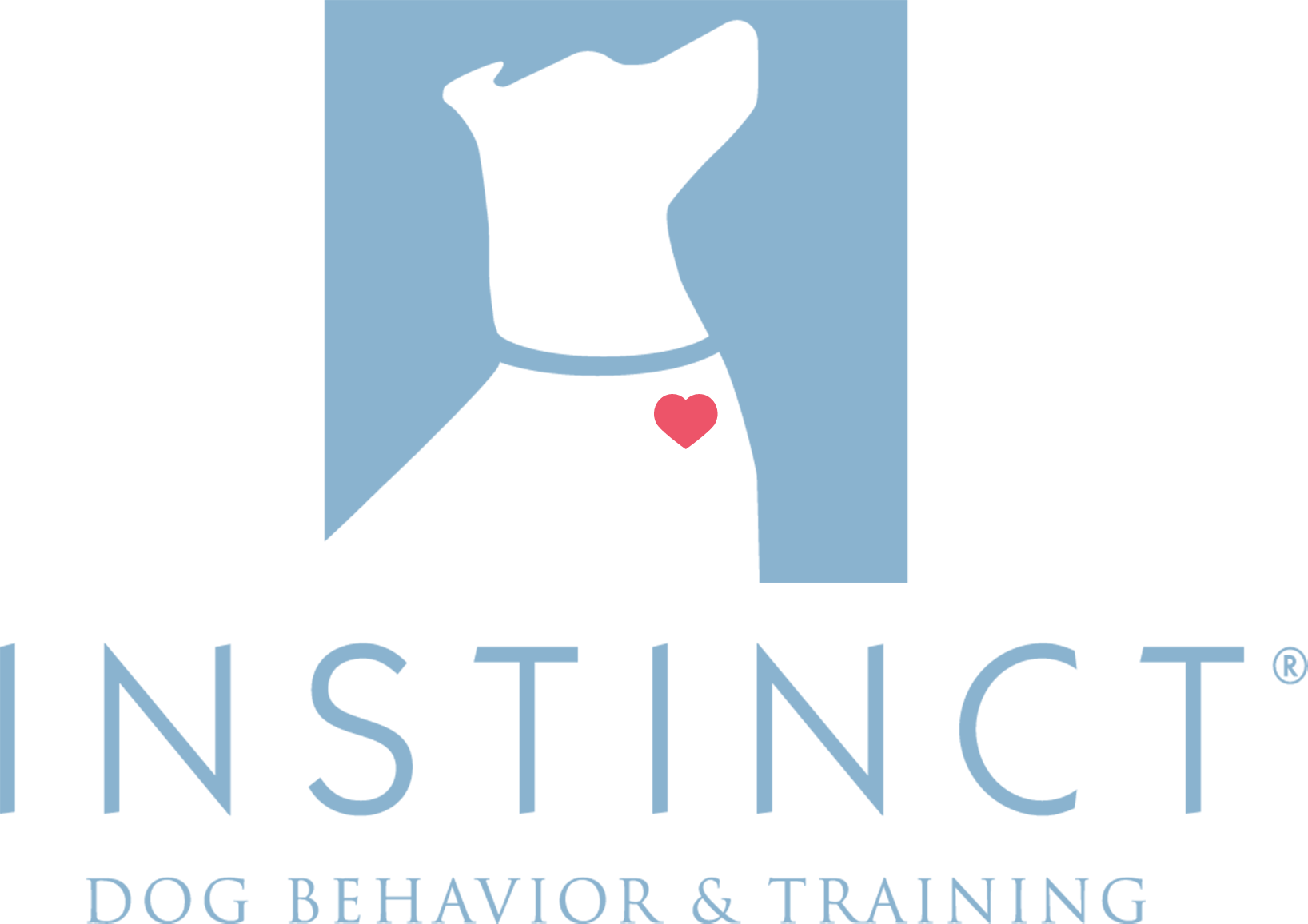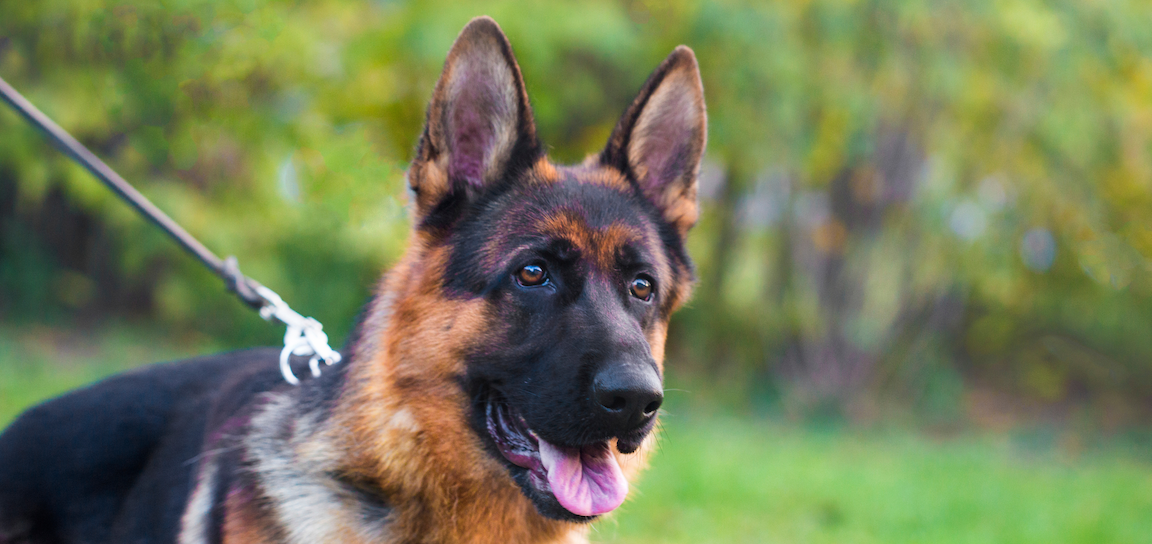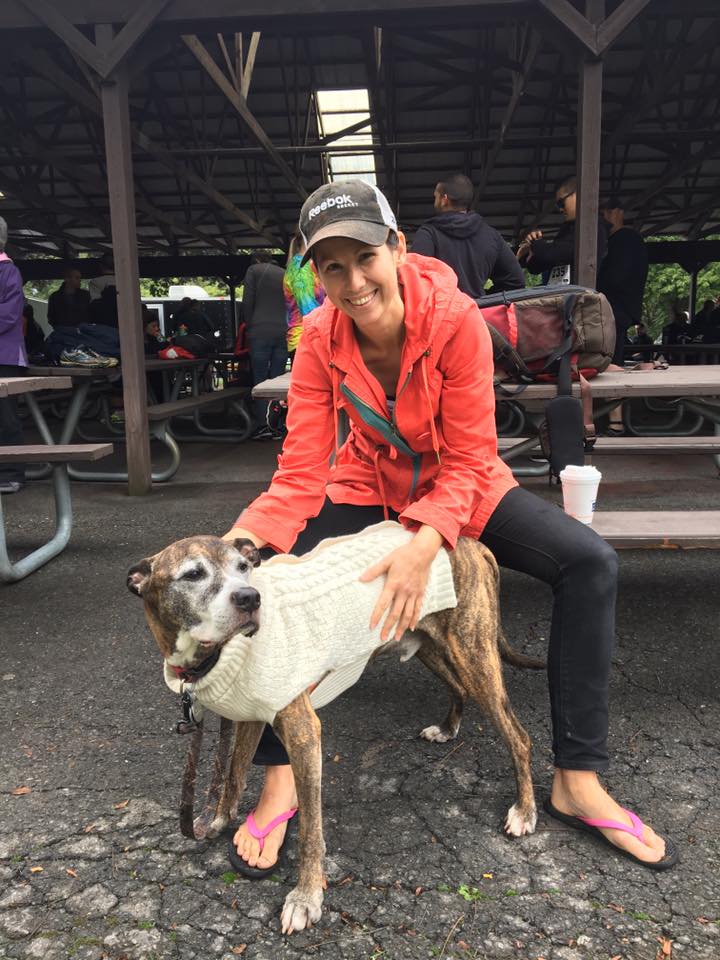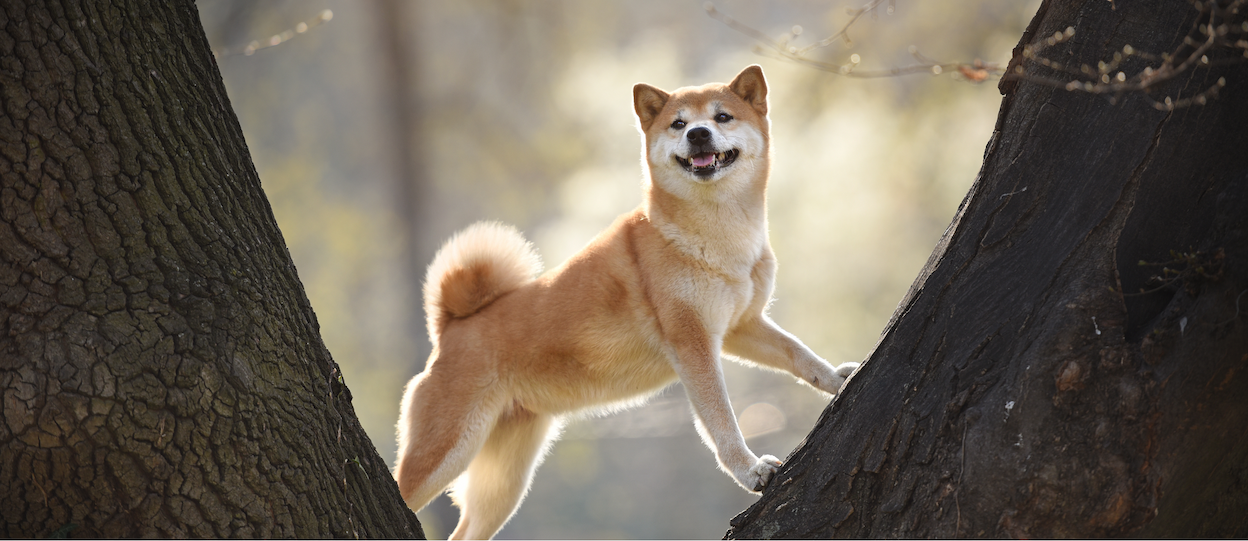
Welcome to the blog!
This week, we’re answering a reader-submitted question about how to address their dog’s unwanted humping behavior.
While the advice given is tailored to this reader’s specific situation, there’s lots of helpful, general information included on this common, misunderstood, and less-frequently discussed dog behavior.
Advance warning: it’s a lengthy one! But, seeing how we respond to reader questions will hopefully provide you with more insight into the steps trainers and behavior consultants go through to choose recommendation options for an individual client and dog.
Happy Reading,

How to Address Unwanted Humping
We received this question from a reader in our mailbox, and thought it was a perfect one to feature in the newsletter:
“We have a sweet baby girl who has overcome some major trauma and developed a lot of confidence. Her only continuing behavior is humping. Sometimes it’s clear that the environment is overwhelming to her, but other times, nothing out of the ordinary is happening. She only humps one parent and not the other.”
We chose this question because it highlights a commonly experienced situation in which a dog is displaying an unwanted behavior with only one person in the household; and, because humping is a behavior that doesn’t get talked about a lot, and it’s one that is also often misunderstood/misinterpreted.
This lovely reader was kind enough to answer several rounds of follow-up questions. Below, you’ll find that additional background information, along with our thoughts and recommendations about how to improve the issue.
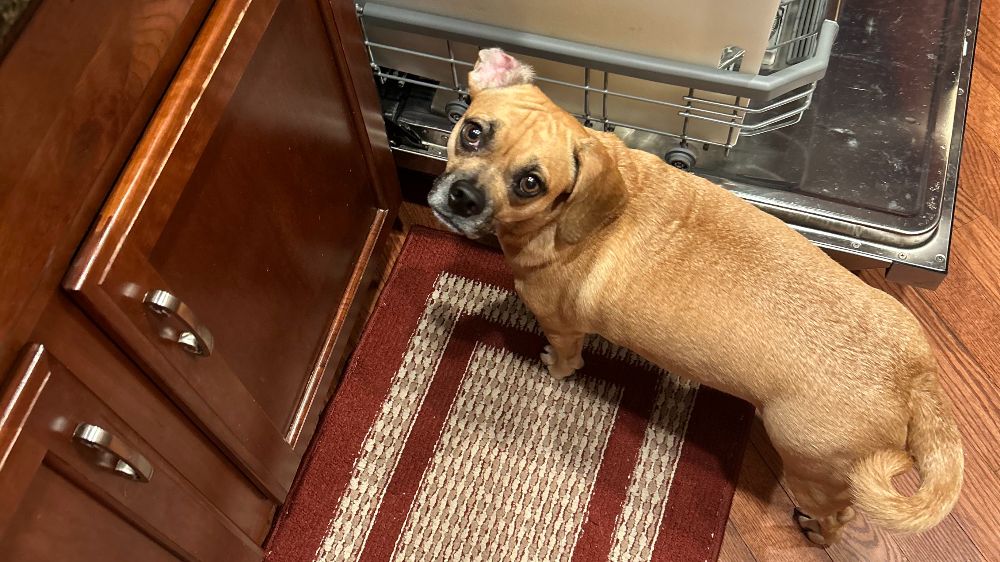
Cana, 2-year-old puggle
Background Information about Cana
Cana is a 2-year-old puggle, rescued by her current family at 6 months old. Her original family purchased her from a puppy mill at age 5 months, then placed her up for adoption 3 weeks later.
Based on her behavior, her owners expect she was crated for long periods, isolated, and reprimanded aggressively for pottying. She is unable to be crated comfortably.
In her current home, Cana lives with her human mom and dad, plus a doggy housemate named Lucca, a 2 year old female mixed breed.
Cana has never displayed any aggressive behavior to humans or other dogs. She loves being close to her people, is chock-full of wonderful puggle personality, and is very into food.
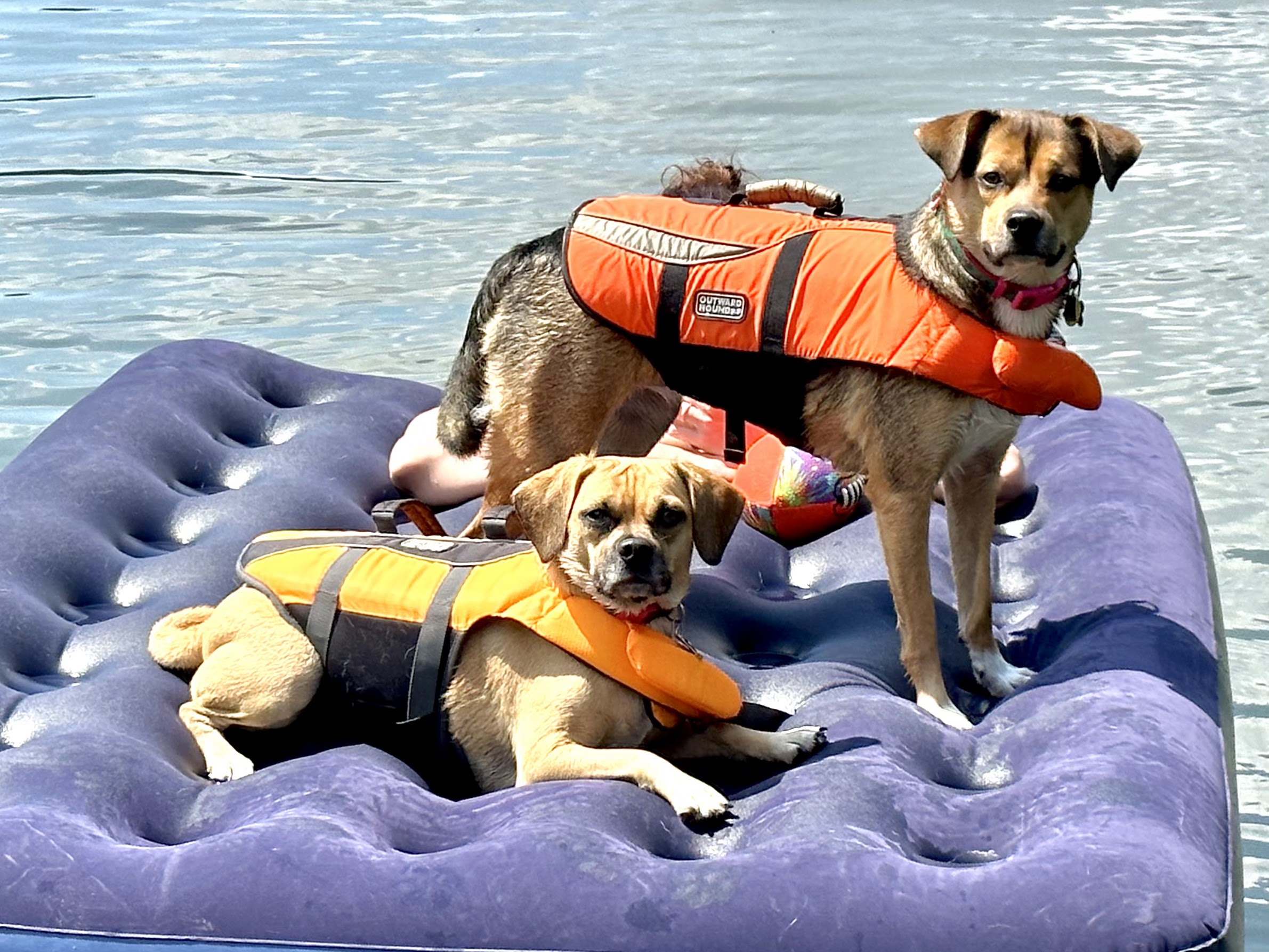
Cana & housemate Lucca
Overview of Cana’s Humping History
TRIGGERS
Cana’s humping is most likely to occur in the following situations:
- When new/unknown-to-Cana guests visit. Cana’s mom says:
- “She’s very excited when anyone comes. Both dogs jump (we’re working on it). Cana wants to smell and greet, but she doesn’t like it when a stranger tries to pet her. If they stand over her and pet her, she barks at them and gets away, but then reengages seconds later. If the guests follow our guidance and bend down, she is more eager to engage with them and be pet. After a few minutes of excitement, both girls go get a toy or bone and go chew on it nearby.”
- The humping attempts usually happen after the guests have been present for an hour or more.
- When Mom plays fetch with Lucca
- Sometimes, when mom tries to play with Cana’s housemate, Cana will approach and try to hump her
- Undetermined triggers
- Sometimes, the behavior seems to happen randomly without a clear trigger present
TARGETS
Cana tries to hump the following individuals:
- Mom (primary target)
- Used to try to hump Lucca, but gave up as Lucca just kept moving away
- Very occasionally tries to hump their (female) dog sitter, who stays at the house with the dogs for a few days every few months (Cana really likes the dog sitter)
- Once, a female adult stranger
- Once, a friend’s toddler
‘TELLS’
(Behavior Precursors to Humping)
Cana’s Mom has noticed that, just before humping, Cana will start to circle her mom’s legs in a very specific way.
TACTICS TRIED
Cana’s Mom has tried the following tactics to interrupt/discourage Cana’s unwanted humping behavior:
- Least successful: Pulling her off, then distracting/redirecting her with a toy or ball
- Mildly successful: Saying ‘no’ as soon as she starts, then pulling her leg away; Cana usually stops for a few minutes, but then tries again
- Moderately successful: Picking Cana up and holding her until she stops (Cana continues to try to hump the air after she gets off mom’s leg). Mom usually talks in a calming voice while holding Cana. This usually works, but sometimes, Cana does go right back to trying to hump again.
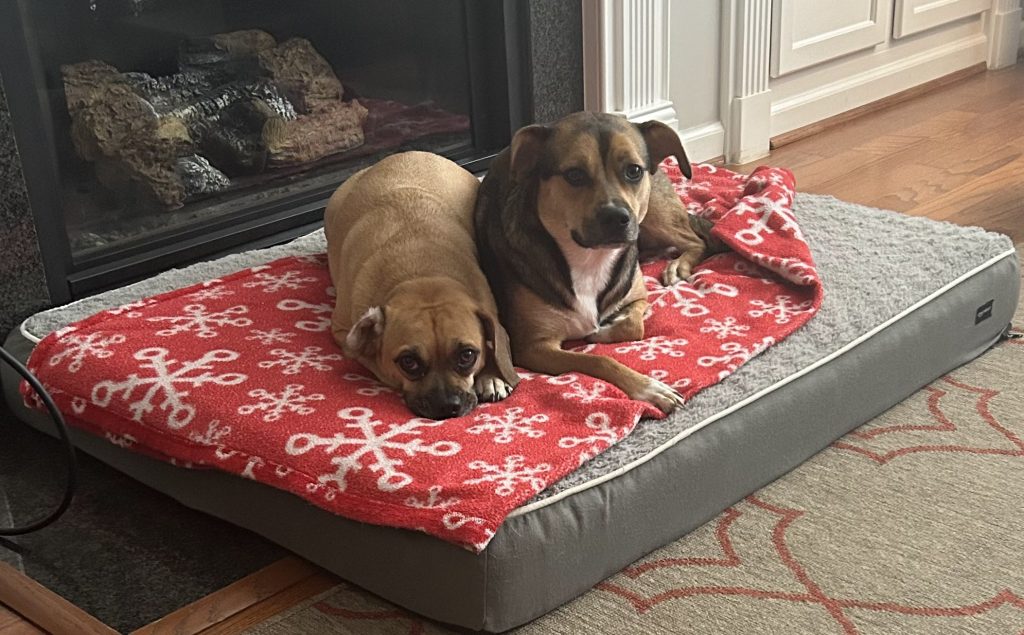
Our Thoughts & Recommendations
First, huge kudos to Cana’s family for helping her to overcome a less-than-ideal start to life, and for providing her with such a safe, loving, and supportive home. And thank you to Cana’s mom for raising this question so we can all explore the topic together!
Disclaimer: The information that follows is for informational and educational purposes only. It is not a substitute for individual behavior consulting.
Reasons that Dogs Hump People
Dogs hump people for a variety of reasons. Following are some common ones:
Self Soothing. Very often, humping appears to be a sort of self-soothing behavior that occurs when a dog is feeling stressed or overstimulated/excited. Often—but not always—dogs who hump to self-soothe are feeling some sort of internal conflict when humping: perhaps, for example, they are happy and excited about a new person visiting the home, but also feeling a little uncertain about this person’s presence. In these cases, the target of the humping may or may not be the individual who is causing the stress or overstimulation.
Stopping Unwanted Behavior. Sometimes, dogs appear to hump someone in an attempt to stop the person from engaging in a behavior (particularly an unusual or stimulating behavior) that makes the dog feel uncomfortable or agitated. For example, a dog may hump someone who is acting emotionally volatile—frustrated, excited, etc.—or who is moving in a way the dog finds odd/concerning—like doing yoga).
Expressing Frustration. Some dogs seem to hump because they feel frustrated about a given situation. For example, perhaps someone is playing fetch with the dog, and the dog is frustrated that the person isn’t releasing the ball fast enough. Or, perhaps the dog starts humping if a person tries to displace them from a certain resting or observation spot.
Attention-Seeking. Dogs will sometimes hump in an attempt to get attention or initiate play, though, in my experience, this is more common with other dogs than with people.
Hormones/Pleasure-Seeking. Dogs also hump for the more obvious hormonal or pleasure-seeking reasons—particularly if they are intact males or females in heat, though other dogs will sometimes hump just because it feels good.
Medical Issues. If a dog is humping frequently, or if humping pops up as a new behavior, it can indicate a medical issue that’s causing irritation or discomfort in/around the dog’s genitals.
Why is Cana Humping? Does Knowing ‘Why’ Really Matter?
Our best guess, based on the information provided, is that Cana’s humping serves a self-soothing function when guests visit, and it serves to (try to) stop an unwanted behavior when Mom is playing with Luca.
Does Knowing ‘Why’ Really Matter?
Almost aways, understanding the underlying motivations for a dog’s unwanted behavior allows us to create a more effective behavior change plan:
While most plans to reduce humping will include some combination of the following:
- Identify triggers/causes of humping, then create a plan to prevent humping attempts as much as possible, through changes in routines and environmental setup, and teaching of needed skills
- Identify and implement techniques to effectively interrupt and redirect humping attempts when they happen
…what, exactly those plans look like will vary based on the dog’s motivations (along with their individual Nature and their Nurture environment).
For example:
- If a dog is humping to self-soothe, we can take steps to build their confidence in certain situations, and also teach them other self-soothing behaviors to replace the humping—like relaxing on a bed, snuffling on a snuffle mat, grabbing a toy to play with, etc. In these cases, we also want to choose a very calm, supportive interruption method that doesn’t add to the dog’s feelings of overwhelm.
- If a dog is attempting to alter a person’s unwanted behavior through humping, we often need to set gentle boundaries about our personal space, and teach the dog skills that more easily allow us to do so. Often, we also provide controlled opportunities for the dog to observe and get used to those movements they find concerning
- If a dog is humping because they feel frustrated, we might work on personal boundaries, but also focus on exercises to help build the dog’s frustration tolerance. We would also be mindful about how we choose to interrupt humping in the moment, and what additional safety/management tools we might put in place, as some frustrated dogs can escalate into aggressive behaviors when someone tries to stop them from humping
- If a dog is humping due to hormonal reasons/for pleasure, someone *might* choose to have the dog spayed for neutered to reduce how often it’s happening. One might opt to provide an “approved” outlet for humping, like a large stuffy kept in a dog’s crate, in combination with having a clear plan for interrupting and redirecting inappropriate humping when it happens.
- If a dog’s humping is due to a medical issue, we seek veterinary care to address the issue, then reassess what, if any, training and behavior interventions are needed to address any humping that continues to occur as a result of the dog having practiced the behavior for a given period of time.
Why is Mom Being Targeted More than Dad/Other People?
Sometimes, an individual person may be targeted for humping because they interact with the dog in ways that leave the dog feeling overstimulated or conflicted (lots of wrestling or physical play, prolonged petting or excited petting, regularly using a loud voice or highly excitable tone when engaging with them, etc).
Other times, the dog may be picking up on an individual’s uncertainty or feelings of discomfort around them, which then creates a cycle of “if you’re uncomfortable with me, I’m uncomfortable with you, too” responses between dog and person.
Neither of these explanations seem likely with Cana’s Mom. Instead, our best guess is that, because Mom handles more of the caretaking duties that can cause Cana to sometimes feel excited or overstimulated (walks, treat giving, etc.), and because mom is around more of the time, she was, at first, simply the more available option. And over time, she became the “go-to” option even when others were around.
Note: There may be an element of comfort level with different gender presentations at play here, as well, given that Cana has only ever attempted humping with women, and with a young toddler. Cana displays some conflicted/uncertain behavior around strangers; it’s not uncommon for such dogs to feel a little more uncertain around masculine-presenting individuals. Thus, when she first joined the family, Cana may have been a little more reserved/inhibited with her dad, and so less likely to try humping him.

Key Considerations in Choosing Intervention Options
While all of the background info shared about Cana is important, there are several pieces of information that rise to the top when it comes to choosing intervention options that we feel are most likely to be effective for Cana and her family:
- Currently, the most effective interruption technique Mom has tried involves physically blocking Cana from accessing Mom’s leg, while also providing calm, soothing feedback; the least effective is an attempt to redirect to a playful/stimulating behavior
- When guests visit, Cana tries to self-soothe by laying down and chewing on a bone or toy (this is awesome!)
- Cana is not comfortable being confined by a gate or crate, due to her early life trauma
- Cana appears to feel conflicted about new people – curious, friendly and social, but also concerned/uncertain about them in certain contexts
- Cana loves food
- Cana has never displayed aggressive behavior with humans or dogs
Intervention Recommendations for Cana’s Family:
Laying the Groundwork
Recommendation #1. Start Behavior Tracking
For the next three weeks, keep a little notebook handy (or use the notes app on your phone) to jot down instances of humping/attempted humping, along what was happening with Cana in the environment just before the humping attempt occurred. If you can think of anything notable that happened earlier in the day (travel, a stressful walk, etc.), include that as well.
Behavior tracking can help you identify ‘triggers’ for those humping attempts that currently feel like they happen randomly. Identifying additional triggers makes it easier to then determine what additional training, routine adjustments, etc., would help Cana feel more comfortable/confident, and less likely to try to hump in those situations.
Recommendation #2. Skill Development
Here are a couple of skills we recommend working on with Cana. These skills can be used in a preventative manner to block physical access to mom during times/situations when humping is likely to occur. And, they can be used as part of our interruption strategy (described in Recommendation #4 below) to help Cana fully settle and relax after she attempts to hump.
- Bed/Stay. If Cana doesn’t already know it, we recommend spending some time each day to develop a very solid, relaxed “Bed/Stay” behavior, where Cana’s mom can ask her to chill out on a mat or bed for up to 10 minutes at a time, around moderate levels of distraction.
- Tether Time. At the same time, we recommend helping Cana can comfortable with being tethered (an alternative to a crate or gate, that can still serve to prevent physical access to mom when needed).
Recommendation #3. Environmental Design
If you’ve worked with an Instinct trainer or taken our Nature-Driven Nurture course, you’re likely well aware of how impactful the environment is on behavioral outcomes.
Here are a few recommendations for setting up your environment to help Cana (and you!) succeed:
- Mats/Beds. Make sure there is a mat/bed for Cana to lay on in any of the rooms where humping attempts typically occur
- Snuffle Mat. Invest in a couple of snuffle mats to use during guest visits, and during tether time training.
- KONGs. If you’re able, consider purchasing 4-6 KONGs or similar stuff-able food toys to use during guest visits (instructions included below). Having extras makes it more likely that you’ll always have a clean one available when needed!
- House Leash. This is an important one. If you don’t already have one, purchase a lightweight leash for Cana to wear inside the home.
Intervention Recommendations for Cana’s Family:
Reducing the Frequency of Humping Attempts
Recommendation #4. Implement a Predictable Guest Routine
Given that the humping attempts usual happen an hour+ into guest visits, it seems likely that Cana’s stress levels are gradually rising over the course of the visit, until she turns to humping mom as a way to relieve some stress and also, potentially, to try to redirect mom’s attention toward her.
Here are ways we can try to make guests visits more relaxing and less stressful for Cana—a good thing in general, and a way to reduce the likelihood that humping attempts occur:
Make the Initial Entry of Guests Less Stimulating:
- Prep a frozen stuffed Kong or hollow bone for each dog prior to the guests’ arrival. Ideally, opt for a size/shape of Kong that your dogs are able to pick up and walk around with.
- In addition, set a snuffle mat down on each dog’s bed.
- If possible, give your guests any dog-related instructions before they come inside. Ideally, text or call them in advance, or, if needed, step outside the door for a quick review when they arrive. You can also post a short list of instructions on your front door if you’re comfortable doing so. Here are some tips on getting guests to ‘buy in’ and follow your instructions:
- Frame it as a request for help: “hey, we’re working really hard to train the girls to be relaxed when people come in. Would you help us with their training when you first arrive?”
- Focus your instructions on telling the guests what to do, vs. what not to do. For example, instead of saying, ‘Don’t Lean Over’, try saying, “Back Straight when Standing” or “Kneel to Pet.”
- Don’t be afraid to set clear boundaries, and include yourself in any boundary setting statements, e.g., “We’re not comfortable with that” vs. “Cana’s not comfortable with that.” People are often more likely to accept and honor a statement about your comfort level vs. about the dog’s comfort level.
- When the guests first enter, scatter some treats on each of the dog’s snuffle mats.
- At first, the dogs may go back and forth between the guests and the snuffle mats. Over time, they’re likely to focus more and more on the snuffle mats and less on the guests.
- After a couple of rounds of dropping treats on the snuffle mats, offer each dog their frozen KONG on their bed. They may opt to parade around with it, to leave it and go to the guests then return to it, etc. That’s all okay! It’ll take some repetition for them to understand the new routine.
- NOTE: Watch the dogs’ arousal levels and body language carefully, and step in as needed to gently make sure the dogs aren’t trying to steal each others’ goodies. If either dog is showing signs of resource guarding their Kong/long-lasting chew, we can regroup on ways to adjust the routine.
Reduce Stress During the Visit:
- If Cana is able to comfortably spend time in another room to decompress for portions of the visit, that’s a great option to try. Lucca can certainly join her if that makes it easier for her.
- If she’s not able to relax in a separate space, that’s okay too! You might opt to take the dogs outside for a little fresh air and potty break in the yard for 10 minutes, every hour or so (you can reduce the frequency of these breaks over time)
- Try positioning Cana’s bed at a spot in the room that feels somewhat private/protected, but still provides a view of the guests. For example, you might try placing her bed at the far end of the couch where you’re sitting, with a guest at the opposite end of the couch or across the room in a chair, vs. putting her bed right next to the entrance to the room, or close to where a guest is sitting.
- As described below, use short bed/stays preemptively if you see Cana’s arousal/stimulation levels rising throughout the visit.
Recommendation #5. Use Bed/Stays Preemptively
As you start to identify potential additional triggers for Cana’s humping through your behavior tracking, you cam opt to preemptively send her to her bed (tethered or not) before a humping attempt occurs. Provide her with a Kong, long-lasting chew, or snuffle mat during these times.
This serves two purposes:
- If Cana is on her bed, she’s not able to hump your leg, and
- Engaging in a relaxing activity like settling on a mat and chewing or licking something yummy can help Cana to down-regulate and make her less likely to try to hump when she comes off her bed.
Intervention Recommendations for Cana’s Family:
Effectively Interrupting Humping Attempts
Recommendation #6. Block the Response, Redirect to a Calming Activity
The recommendations above are important to help reduce the overall frequency of humping attempts in the future. But we can’t stop there.
It’s also really important to have an effective strategy for blocking and redirecting humping attempts when they do occur—one that supports the overall goal of reducing the frequency of the behavior while also helping Cana feel confident and comfortable moving through her day.
Here’s what we recommend:
- Use a House Leash. For the next 6 weeks, whenever you are home with Cana, have her drag around a lightweight leash attached to her harness or collar. If you are concerned about the leash catching on things or getting tangled when Cana and Lucca play, you can cut the leash so it’s only about 3 feet long with no loop on the end.
- Why? The leash will provide you with a highly effective way to calmly and quickly block Cana from accessing your leg, without having to physically pick her up and hold her, or try to push her away with your hand. It will also provide you with an effective way to guide her to her bed, if needed, to help her fully settle/relax.
- Intervene Early; Block the Response.
- Whenever Cana starts circling your legs in that telltale way that forecasts a humping attempt is coming, calmly pick up the leash as you say something like, “No thank you, Ma’am” in a calm, firm-but-friendly tone, and hold the leash away from you so Cana can’t access your legs.
- You can keep light, steady tension on the leash as needed (just enough to prevent her from moving toward you) until she diverts her attention away from your leg.
- Once she loses interest, calmly drop the leash and resume whatever you were doing.
- Redirect to a Calming Activity If Needed.
- If Cana returns to try humping again, or if she tries in earnest for more than 60-ish seconds to keep getting at your leg while you’re blocking access with the leash, or if she quickly escalates into frustrated barking at being denied access to your leg, you can calmly tell her, “let’s go settle”, and then cue her onto her bed and ask her to stay for a few minutes.
- Provide calm praise when she goes onto her bed. You can make sure there is always a bone or chew toy on the bed for Cana to access if she wants, but hold off on rewarding her with food in these moments to avoid an unwanted behavior chain developing.
- If Cana tries to get off her bed repeatedly, you can attach the tether to see if it helps her settle (only do so after you’ve worked on tethering and you know she’s very comfortable with the setup in other contexts)

Focus on HELPING Your Dog
Humping is one of those behaviors that many of us find highly annoying (or downright offensive). It’s easy to get pretty emotional, agitated, etc. if a dog tries to hump us—especially if it happens repeatedly.
If unwanted humping is an issue with your dog, try, as much as possible, to hone in on the feelings that are driving the unwanted behavior. Then, focus on helping your dog resolve those feelings in a kind, productive manner.
Cana’s Mom seems like she’s already doing an amazing job of this! We hope the tweaks we’re recommending above will help them make some additional progress.
NEED TRAINING OR BEHAVIOR SUPPORT?
Check out the resources below!

Check out Instinct’s award-winning podcast, Dogs Unknown (fka DogLab), hosted by Instinct Co-Founders Sarah Fraser (me!) and Brian Burton.

Join one of our free, live training & behavior seminars via Zoom!
Hosted by Instinct behavior consultants, these seminars include a 1 hr presentation plus live Q&A session. Open to all!
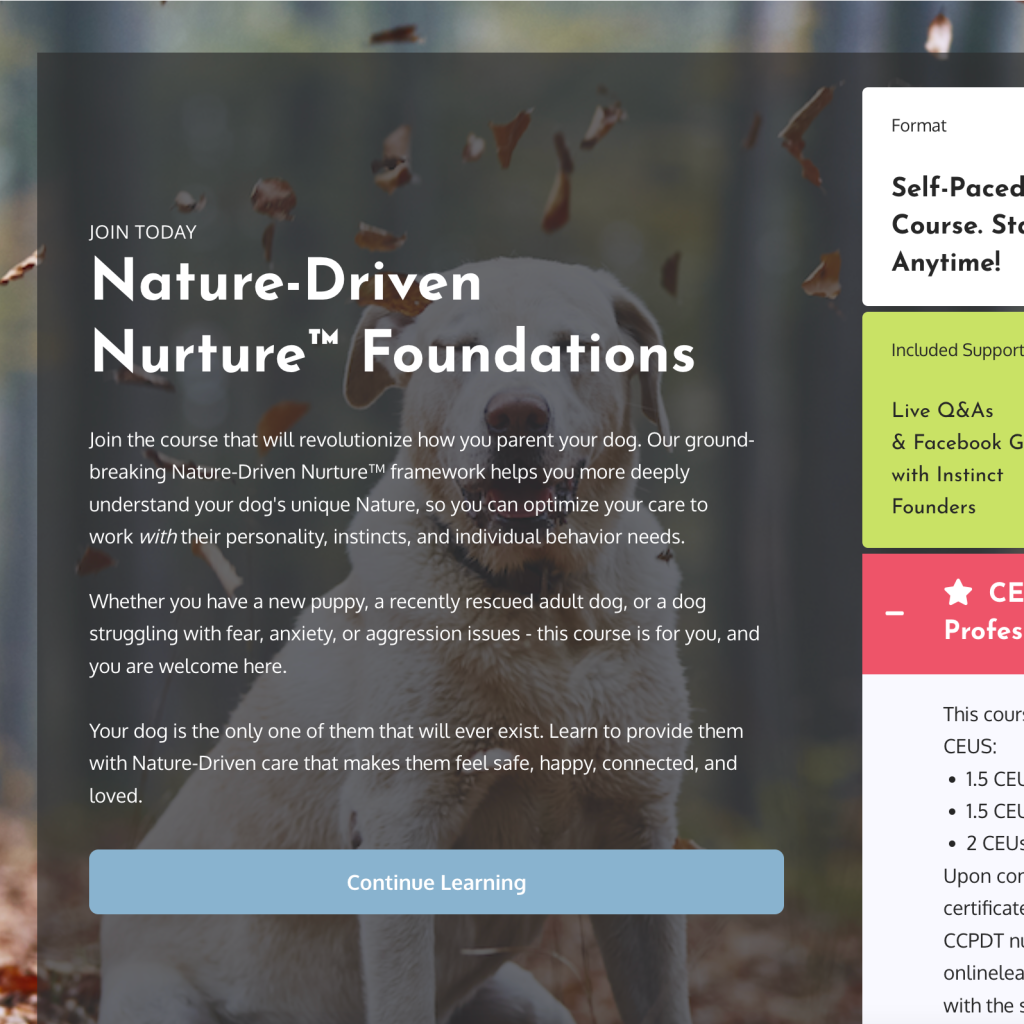
Sign up for the Nature-Driven Nurture Foundations course in our Online School. Learn our groundbreaking canine behavioral health framework that teaches you how to optimize your dog’s training & care based on their unique, individual Nature. This self-paced course includes:
- Access to private Alumni Facebook group
- Twice-monthly Zoom Q&As with Instinct co-founders
Or, contact your local Instinct for fully customized training & behavior support with certified, veterinarian-recommended trainers and behavior consultants.
